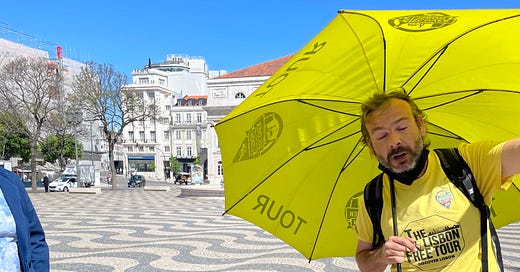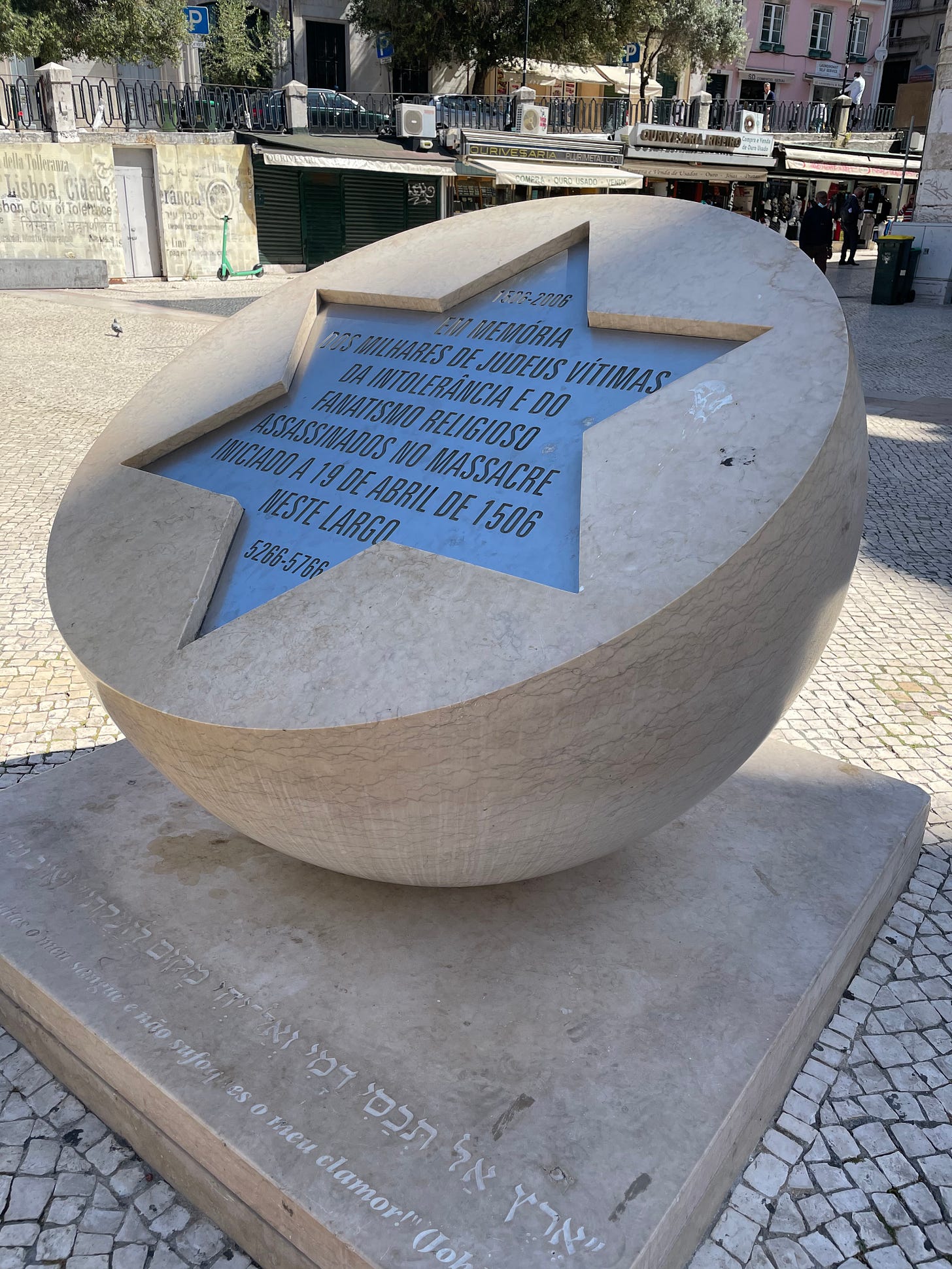When arriving in a new city, I always google “free walking tour”. Most major cities offer them. The company may be Sandemans, or Strawberry Fields, or as I found in Portugal Guruwalk. Não faz mal (“no worries”, for you newer readers) they will offer an English language tour.
Not Free but Well Worth It
We called the friends that are currently living in Lisbon but will be moving to Tavira, to see if they wanted to join us. Since they had never been on such a tour, we explained that free walking tours are not supposed to be free. At the end of the tour, you tip your guide whatever you think the tour has been worth. As our guide, Nuno said, “If I am terrible give me nothing. If I was just bad 5 euros, good 10 euros, fantastic 20 euros, the best tour ever just give me your bank account number.” So far all our tours, have been fantastic or better.
A good guide, like Nuno, will give you lots of information during the tour. As is required in Alfama, which is among the hilliest sections of Lisbon, he paced the 2.5-hour tour stopping at interesting points along the way to ensure everyone could keep up. We have found many guides are out-of-work actors or comedians (Nuno for a while did standup) making them comfortable, engaging, and good communicators. So if you haven’t figured it out by now, we recommend you look for “free walking tours” whenever you get to a new city. It is a great way to get your bearings and learn something along the way.
Lisbon Massacre
We met in what is popularly called Rossio Square. We learned that its rounded corners dated back to ancient times when it was used as a hippodrome. We walked one block and stopped at the memorial you see above. We then learned about the Lisbon Massacre, also known as the 1506 Easter Slaughter. Nuno explained many Jews had fled Spain and taken refuge in Portugal. King Manuel I was more tolerant of the Jews, in part because they were literate and could do mathematics.
The Christians were not very fond of the Jews. In fact, conversion to Christianity was “made compulsory”. Many Jews, to fit in or because they were true believers, became “New Christians”. At the same time, there was a significant drought throughout Europe and the second wave of the Black Death/plague. So on one Easter Sunday, Christians were gathered in a nearby church. Sun streamed through a high window and hit the cross at just the right angle to make it glow. The congregation excitedly agreed that this was a sign…they would be delivered from their suffering.
But one member of the congregation, a New Christian said, “Hold on there. It is just a reflection from the light coming in the window.” He was dragged from the church and beaten. Then he, along with all the other New Christians they could round up, was burned to death. Over 500 people were slaughtered that day. Dominican Friars promised absolution to anyone involved in the killings, and thus it continued. Over the next few days, as many as 4000 Jews were ripped from their homes, beaten, or burned. Children were not spared. Their homes were looted.
And then…
The King’s Royal Guard restored order a few days later. Some Portuguese were prosecuted. The Dominican Friars were executed. But a few years later began the Inquisition. And so we see a monument not to a single event but to years of persecution and discrimination. A monument that was unveiled 500 years later and reads:
In memory of the thousands of Jews who were victimed by intolerance and religious fanaticism, killed on the massacre that started on 19 April 1506, on this square.
And around the base, is etched a verse from the Book of Job:
"O earth, cover not thou my blood, and let my cry have no place."
Writer’s Note: If you are interested in Portugal’s Jewish history, you might like this post.






Heartbreaking, isn’t it? I keep hoping that we as a species are moving past that sort of horrific behavior...
Nancy’s post about the Alfama Walking Tour in Lisbon offers an insightful look at the city's rich history, including the harrowing story of the Lisbon Massacre. It’s fascinating how walking tours can reveal so much about a city’s past, like the cultural, religious, and political tensions that led to such tragic events. Whiteman’s experience with Nuno, the engaging guide, made me think of my own nyc walking tour with https://www.vibenyctours.com/, where our guide shared deep, often untold stories about New York's neighborhoods. Just like in Lisbon, these tours bring a city’s past to life in a way that books or museums sometimes can't. Whether in Lisbon or New York, walking tours allow you to truly connect with the history of a place and understand the events that shaped its people and culture.